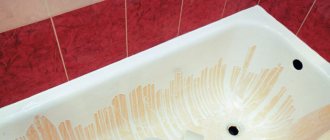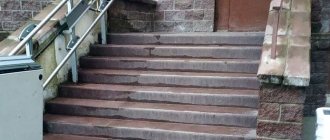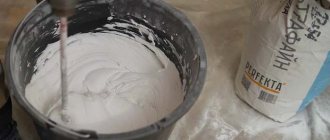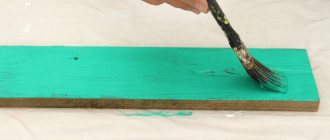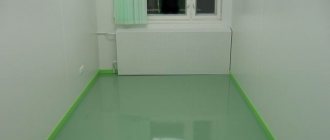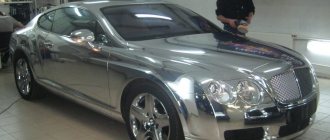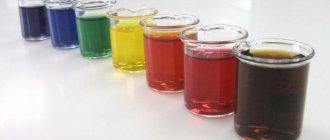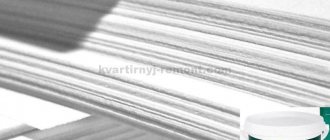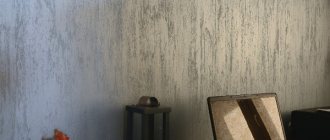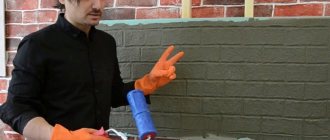Neon wall paints are used relatively rarely in interior design. The only exception is the decoration of clubs, bars, dance floors - that is, rooms with a very specific type of lighting. And yet, such compositions can be used in an ordinary apartment.
The main thing is to know how to work with them correctly and how to fit them into the design as organically as possible.
Applications of neon pigments in decoration
Characteristics and properties of neon paint
Luminescence or the ability to glow in the dark is a property that dyes acquire due to the addition of a phosphor (neon) to the original composition. This substance can accumulate solar energy during the day. After turning off the light, including artificial light, the phosphor coating glows for 7-8 hours.
There is an important difference between luminescent and fluorescent dyes. The former glow in the dark thanks to accumulated solar energy, the latter - ultraviolet radiation.
The composition of such dyes includes the following types of phosphor:
- Organic. This phosphor is based on naphtholic acid. This substance, accumulating solar energy, glows due to neon radiation. Because of this feature, organic phosphor coatings periodically emit momentary flashes.
- Inorganic. This phosphor consists of crystal phosphor components that emit uniform and constant light.
In addition to phosphor, acrylic paints are used in the manufacture of such materials, which act as a binder.
This component has the following characteristics:
- versatility (suitable for finishing various materials);
- high plasticity;
- resistance to abrasion and other external influences;
- high speed of drying (polymerization).
Distilled water or special mixtures are used as a solvent in neon dyes.
Let's look at ways to prepare neon paint.
Today there are a lot of recipes for creating luminescence with your own hands.
To do this, for example, you can acquire a neon paint and varnish material consisting of soluble phosphor substances.
People call it neon (but the absurdity is that there is not a drop of neon in it!). The coating will glow due to the luminescent pigment found in acrylic.
The principle of operation of this substance is as follows. Throughout the day, the rays from the lamp and the sun, which the acrylic absorbs, must be directed onto the paint product, and then when it becomes dark, it will all emit radiation (lasts about eight to twelve hours). This time is enough to fill the room with light from the outside, and the upper ball stores such energy that it will manifest itself with the onset of darkness.
The procedure itself proceeds in cycles, so the phosphor will not be destroyed, and the radiation can continue for a very long period of time.
The only thing is that such coloring material belongs to the category of expensive and cannot “boast” of color abundance. Because of this, it is not always possible to obtain multi-colored radiation from the surface of walls in a room.
It is quite possible to make paint with a luminescent effect at home with your own hands. You need to get a special set of neon pigments.
They are considered universal and have the following advantages:
- Resistant to extreme cold (this is important for painting a car, but they can also be used for walls in a darkened room, hallway, basement or attic).
- Environmentally friendly components that do not cause dermatitis or allergies. This is especially important when used in a children's room.
- Heat and wear resistant (stay at +30°). But if the sun's rays hit the wall, the glow will be better, but it is still advisable to cover the painted wall with acrylic with fluorescent pigment with curtains or curtains.
- Can be used for interior and facade decoration.
- This coating will last 25-30 years.
“Emissive pigments are made up of chemicals that will work well in other types of paints (alkyd resins or polyurethane). In this case, the varnish must be colorless, otherwise the result may be far from expected.”
Be that as it may, before preparing a neon paint composition yourself, you need to do an experiment on an inconspicuous area of the wall that is constantly exposed to sunlight (in order to understand what kind of coating you will get in the end).
Scope of application
Paints that glow in the dark can be used for:
- finishing of facades, entertainment facilities or structures in park areas;
- painting warning signs or signs;
- drawing on the body (body art);
- product labeling;
- road markings;
- design of railway fencing.
Expert opinion
Zakharova Irina Yurievna
Cleaning professional with 15 years of experience. Our best expert.
Ask a Question
Dyes that contain phosphor are also used in printing - for printing business cards, greeting cards and more. This pigment is used to decorate bicycles and other vehicles. In addition, this substance is added to tissues.
Application area
When mixed with clear varnish, the phosphor transforms into luminous paint. The luminescent base is used in the following situations:
- decorative finishing of the room (walls, ceilings, floors);
- painting individual elements or entire furniture (tables, chairs, armchairs, sofas);
- actors' makeup, theatrical costumes;
- floristics;
- painting window frames, fences, gazebos, etc.;
- posters, advertising signs;
- tuning of cars and bicycles;
- overalls, road signs.
Advantages and disadvantages of the material
Among the advantages of such finishing materials are the following:
- long service life (they remain on building facades for 30 years);
- frost resistance;
- versatility;
- chemical neutrality (do not provoke allergic reactions and other side effects);
- do not collapse when exposed to temperature;
- tolerate direct contact with sunlight.
See also
What types and types of paints are there, classification and description of the 10 main ones
There are no disadvantages to luminous dyes. It should be taken into account that such compositions are used in highly specialized areas. For example, painting bedrooms in materials that glow in the dark is prohibited.
Types of fluorescent paint
Construction stores sell many different fluorescent products. A huge selection of sets is presented in Leonardo stores and online centers for artists. The most popular brands are Kudo (Kudo) in aerosols, acrylic aerosol paints Bosny, Decola, Paint Glow, various materials made in China.
Acrylic materials
Acrylic based paints are the most popular. Thanks to the water in the composition, it is an aqueous dispersion of acrylic. Using such means they work on paper, cardboard, and draw pictures. The material is harmless, non-toxic, and has a low odor. Some acrylic paints are purchased specifically for children's crafts and crafts - the compositions are ideal for making drawings on leather and wood. Acrylic dries quickly, is easy to use, and consumption is low.
For body
Typically, body art is preferred by teenagers who often visit clubs and people who lead the life of a “party animal”. Sets of fluorescent paintwork materials contain 8 colors or more; they can be mixed together to create new shades.
The paints are safe for the skin, do not absorb, but are quite expensive. Stays on the body for up to 18 hours, helping to create an original image. Some materials change skin tone and are noticeable during the day.
For hair
A popular fluorescent dye that can be applied to hair is Manic Panic. There are three tones of the product - blue, red, yellow. The color will shine beautifully on light hair, but will not look so catchy on dark hair.
For fabric
Using similar means, they paint clothes (T-shirts, jeans) and shoes (sneakers, sneakers). An example of a dye is JAVANA for fabric. After application, the product will have to be washed by hand, otherwise the print may deteriorate. The dye is suitable even for silk.
Fluorescent enamel
Enamels are used for interior work. They have an acrylic or polyurethane base, and the color range is very diverse. To create new shades, different paints are mixed together. Interior paints and varnishes are used to create a beautiful design inside the house; they are used on plaster, drywall, and wood. The compositions are suitable for metal and plastic, but adhesion will be somewhat worse.
Enamels can also be intended for external use (for facades). They have added special components that increase weather resistance, resistance to friction, and water-repellent qualities. The finished coating does not interfere with the vapor permeability of the base material. Facade paints are well suited for stone, metal, wood, concrete, brick.
Aerosol composition
Typically, spray paints are created on an acrylic or urethane-alkyd base. The materials are universal and can be used indoors and outdoors. It is convenient to use paints and varnishes in cylinders; the coating will be very beautiful and resistant to water, temperature, and sun.
Powder paint
Fluorescent powder compositions are used to create road markings, paint buildings, car tuning, and paint road signs. Paints are applied with spray guns
You need to work carefully, observing personal protective measures.
Invisible paint
Invisible paint has one special feature. During the day, the coating is almost invisible on the surface, and the paint appears only under the influence of ultraviolet radiation or artificial lighting. It is almost transparent in appearance and contains special pigments that react to light.
Varieties and recommendations for selection
Glow in the dark paints are divided into 3 types:
- Luminescent. The most popular type of neon paint based on phosphor. This composition is characterized by increased resistance to external influences and does not harm humans. Therefore, luminescent paints are in great demand.
- Fluorescent. The basis of this dye is acrylic varnish, which also does not harm the body. But fluorescent materials accumulate ultraviolet light. That is, in order for such a coating to glow, a special lamp must be installed in the room. Fluorescent paints are available in a wide range of shades.
- Phosphorescent. This dye is rarely used, since the material is based on phosphorus, a substance dangerous to humans. More often, phosphorescent compounds are used when finishing car body parts.
Neon paints are also divided into the following types:
- Colorless (translucent). These materials, which are based on varnish, are used when painting surfaces with an already applied pattern.
- Colored. When making such neon paints, a pigment is added to the initial mixture, which gives the composition the appropriate shade.
In addition, these materials are divided according to the type of base component:
- Acrylic. These materials dry quickly and are used for painting various surfaces. In particular, acrylic neon paints can be used in body art.
- Polyurethane-mineral. They are mainly used for painting plastic.
- Heat resistant. An expensive type of paint that is used for finishing surfaces heated to 500 degrees.
- Water resistant. After drying, the paints create a moisture-proof film, which is why these compositions are more often used when decorating bathrooms and other similar rooms.
The choice of neon paints is determined by the area of application of the material. Acrylic compositions are considered optimal. Such materials can be used both to decorate the facades of buildings and to decorate interior spaces.
In addition, there are luminescent paints on the market that come in spray cans. Such aerosols are used to treat small surfaces. One can is enough to paint two square meters.
Glow sprays, like acrylics, are suitable for finishing a variety of materials, including drywall, wood and concrete. Such compositions are often used to decorate structures located on the street.
See also
5 types of primers for floor screeds and a rating of the best brands and how to apply them
How to make glowing paint from phosphor powder
They learned to make their own phosphor paint many centuries ago, when they began to extract pure phosphorus. Unlike phosphorus mixtures, phosphor mixtures do not emit harmful fumes. You can make paint with phosphor yourself. Substances that will be required for this:
- A self-charging pigment capable of emitting a glow;
- Ready-made varnish intended for the selected type of surface;
- Solvent or thinner that matches the varnish base;
- A mixing container made of glass, cermet or porcelain (you need a not very porous, chemically neutral material).
Stages of preparing self-luminous varnish:
- Pour the finished coating into the prepared dishes;
- Add phosphor there in an amount from 1/3 to 1/2 of the volume of varnish;
- Add up to 10% solvent;
- The mixture is thoroughly mixed;
- If necessary, the varnish composition is tinted with soluble pigments. The result will be thick enamel, ready for application.
You can make your own luminescent paint for the street, interior, and landscape design of a suburban area.
Unlike phosphorus mixtures, phosphor mixtures do not emit harmful fumes.
When painting, you must adhere to some rules:
- The surface must be pre-cleaned so that there is no dust and debris, and then dried;
- Before application, the mixture is stirred again so that the phosphor that has settled to the bottom rises to the top;
- The second layer of coating is applied only after the first has dried; the recommended interval for acrylic varnishes is from 1.5 to 2 hours.
The phosphor intensely emits light on white surfaces. It is advisable to pre-prime black or dark objects or paint them with white enamel on the same basis as luminescent paint.
The second layer of coating is applied only after the first has dried.
The principle of using luminous paint
When painting surfaces using neon compounds, you must adhere to the following rules:
- Before application, the surface is leveled, cleaned of dirt and dried;
- neon paint is thoroughly mixed (there should be no sediment);
- the composition is applied in at least 2 layers;
- You can apply the second layer 30 minutes after the first.
It is not recommended to apply neon paints to black surfaces. This color also absorbs solar energy, which can negatively affect the quality of the glow of the main coating. Therefore, if the surface cannot be repainted, a primer should be applied over the base finish before work begins.
It is recommended to paint in a shaded area. This will allow you to control the accuracy of the drawing.
Features of using neon paint in cans
Aerosols are produced for the design of facades and interiors. One package is enough for a single-layer treatment of 2 square meters of area. All neon colors are transparent and vary in their night glow. You can find all the colors of the spectrum from red to violet, super-bright ones - light green (neon) and blue.
To form a uniform layer, it is better to do double spraying. Mixtures packaged in aerosols are alkyd and acrylic. Spray cans can be used to treat any surface:
- Concrete;
- Brick and block masonry;
- Plaster;
- Drywall;
- Wood;
- Wood board;
- Cardboard;
- Thick paper;
- Polymer finishing (any types of plastic, foam);
- Metal;
- Glass.
To create drawings, the contours are sealed with masking tape to create an even border where the color transitions.
To form a uniform layer, it is better to do double spraying.
For wall decoration in an apartment
Neon paint is often used for artistic wall painting and ceiling decoration of nightclubs. In an apartment with luminous decoration, it is worth observing moderation. Light-emitting finishing is appropriate on the ceiling and along the baseboards. On the walls, paintings, lamps, and stucco decorations are framed with luminescent paints.
On the walls, paintings, lamps, and stucco decorations are framed with luminescent paints.
In landscape design
Neon paint in cans for stone was invented by landscape designers. A transparent layer adds color to the evening landscape. You can make a luminous version of borders, add light to the design of rockeries. The phosphor can glow with slight attenuation for up to 12 hours. In the southern regions, where it gets dark early, light-emitting paints are an ideal option for wooden fences, garden furniture, and light gazebos. You can highlight window frames and path contours.
A transparent layer adds color to the evening landscape.
Glowing paint has become a common attribute of nightlife establishments; shop windows and park areas are decorated with neon. Due to their versatility, self-luminous compositions are widely used for practical purposes. You can create an unusual interior yourself; making a dye with a phosphor is not difficult.
Drying time and durability of the coating
The drying time of neon paint depends on the air temperature and the base component with which the phosphor or other similar substance is mixed. On average, this process takes up to 3-4 days. In this case, the paint begins to gain strength 30 minutes after application. Therefore, work with such compositions should be carried out quickly.
The durability of the coating is also determined depending on the type of the main component. Heat-resistant dyes that can withstand significant temperature fluctuations are considered the most durable. Acrylic and polyurethane materials withstand mechanical stress well. And moisture-resistant coatings retain their original characteristics with constant contact with water.
Safety precautions
When working with such compounds, it is necessary to ensure effective protection against poisoning. This applies to acrylic paints to a lesser extent, but for nitro enamels and luminescent products this task is very relevant.
However, following the standard recommendations will be quite enough:
- Firstly, you need to work in a well-ventilated area. Also, you should not stay in the room for the first 12 hours after treating surfaces with fluorescent compounds.
- During work, it is necessary to wear protective equipment: gloves, a respirator, safety glasses with sidewalls.
Safety glasses will be very helpful
- If paint falls on the skin or mucous membranes, the material must be quickly washed off with a large volume of water. If irritation occurs, you should consult a doctor for qualified help.
Disadvantages and features of paint
Fluorescent paints also emit light during the daytime. However, in the dark their light becomes 3 times brighter and more saturated. For this reason, this paint is often chosen for night decoration and various types of markings. To make surfaces coated with this paint look stylish even during the day, you can use colored fluorescent products.
They can be white, blue, green, red, brown or light blue. Transparent colors will be almost invisible during the day. This dye will not glow on its own. When exposed to ultraviolet rays, its bright glow will increase tenfold.
If you don’t know how fluorescent paint differs from its luminescent counterpart, you should take note: the latter has an independent illumination effect. The duration of this effect can last up to 10-12 hours. Over the course of a whole day, painted surfaces absorb light; with the onset of darkness, they begin to glow autonomously. This difference allows you to accurately select the right type of paint.
There is also reflective dye. It acts as a reverse reflection of the light flux: as soon as the light hits the painted surface, the rays are immediately reflected at a distance of 200 - 250 m. This paint is selected to increase safety on the roads.
Different types of fluorescent materials are suitable for coloring:
- metal products (they can be used to cover car rims, road signs, and various objects);
- different fabrics (depict designs on clothes, use for advertising purposes);
- glass and ceramic products (this could be tableware or stained glass painting);
- the human body (can be found in body art) and on the leaves of ordinary plants;
- wood (you can paint fences, decorate gazebos, window and door openings);
- stone and concrete (painting walls, garden paths, city alleys, building facades);
- plastic (products made of PVC, polystyrene and other plastic materials).
In addition to the ability to glow beautifully, fluorescent materials have other characteristic features. Among them there are both advantages and disadvantages. Let's look at the key points.
Fluorescent paints can fade in a matter of months when exposed to light (if used externally). To make the dyes fade more slowly, a modifier is introduced into the product, which absorbs UV rays. In addition, the coating with already applied paint can be painted over with transparent varnish. But the brightness of the paint will be reduced.
A fluorescent coloring product will become extremely unstable after unsuccessful tinting. To give the surface durability, it is better to immediately buy ready-made material in the desired color.
Grain
Fluorescent paints and varnishes disintegrate at temperatures of 150 – 250 degrees C. They completely lose their ability to glow brightly.
You only need 15 minutes of bright daylight or artificial light to charge the applied paint for 8 full hours of use. The process of light accumulation is a completely continuous cycle. Product manufacturers guarantee that their luminous paints will work for at least 30 years.
Coatings cannot emit a glow forever; the structure of the fluorescent layer is gradually destroyed under the influence of sunlight. You can protect a surface treated with a fluorescent compound by applying a layer of transparent varnish on top. In addition, varnish will add gloss to such a surface; without it, the texture will look matte or even slightly rough. Another disadvantage is the low temperature resistance; already at 100–150 °C the paint layer is destroyed.
Species diversity
Glowing paint can be transparent (neon), translucent and colored. The first type is used for drawing. If the coating has a tint, it is visible during the day, and at night the treated surface glows.
Color spectrum
Luminescent compositions are not characterized by a wide color palette. The most common are yellow, orange, blue and green coatings. At the same time, at night the paint can give a different shade: light green, pink. Colors can be mixed.
Areas of use
Glowing paint is used in the following areas:
- transport: the substance is applied to signs, fencing structures, road markings, parts of the car body;
- household: for decorating the entire area of the wall, ceiling, furniture or decorative elements (shelves, bedside tables), for drawing patterns on various surfaces in the children's room;
- textile industry: production of workwear, printing logos on T-shirts;
- advertising: application to posters, billboards, banners, signs;
- in the entertainment sector: paint is used to decorate stage costumes, as part of makeup, and for body painting;
- landscape design: for processing elements of street decor;
- printing houses: application to calendars, notebook covers;
- floristry: aerosol compositions are sprayed onto plants.
Luminescent paint adheres well to concrete, metal, glass, plastic and wooden surfaces.
Glowing paint is used in the entertainment industry for body painting, as well as as part of makeup.
Classification by composition
Depending on the constituent components, the following types of compositions are distinguished:
- Polyurethane-mineral. They have good adhesion to the base, so they are often used for application on smooth surfaces: plastic, glass.
- Acrylic (water-based). They are characterized by quick drying and safety for living organisms.
- Water resistant. Such paints are not susceptible to the negative effects of water. They are used to decorate the bathroom and swimming pool.
- Heat resistant. These compounds are applied to ceramics, glass and other materials that will be susceptible to high temperatures. The coating does not lose its properties at +400ºС.
Before use, shake the container to remove sediment.
Applying and removing paint
Paint with luminous particles is applied to the surface of the body with a brush, hands, sponge, or swab. It is possible to spray the material from a spray can.
Before applying luminous paint, the skin must be cleaned and moisturized with special compounds.
To enhance the brightness of the glow, you must first apply a light tone - white or a pastel shade. Experts recommend applying several layers of dye. After drying, the composition forms a radiant film on the skin.
You can do the painting yourself or use stencils to create graphic lines. When performing complex drawings, it is recommended to carefully draw the outline of the planned image.
Glowing paints allow you to combine contrasting colors or create smooth watercolor transitions of shades on the body, or create shading. Clear lines for theatrical or costume performances look original.
Fluorescent paints are also produced in the form of pencils for applying images to the body. The composition can last up to 3 days. Special transparent liquid fixatives will help fix the image for up to 7 days. Luminous compositions are also produced in the form of markers and felt-tip pens for tattooing. The tool is easy to use and comes in a range of bright neon shades. Validity period – up to 3 days.
Coloring materials containing glitter in the form of powder with inclusions allow you to create a three-dimensional effect. Materials must be applied over body paints. The work is carried out before the composition dries so that the elements stick to the body.
The peculiarity of the materials is the ability to quickly cleanse the skin. The compositions remain on the body until taking a shower. The luminous paint is washed off with warm water and soapy water. Optimal are specially developed makeup removers in the form of milk, cleansing oily cream that does not damage the skin, etc. It is recommended to wash off paints with solid particles (glitter) using scrubbing agents, soap and warm water.
Phosphor properties
The quality of the glow of the pattern on the body depends on the time the car was in the sun. Self-luminous paint will “burn” brighter if it has spent significant time in direct sunlight. You can “recharge” such images yourself, using xenon or halogen lamps, which you need to irradiate the vehicle body for at least half an hour.
Porshe 911: body tuning with glowing paint
The duration and intensity of the glow is also affected by the quality of the phosphor. The picture can be visible from 2 to 36 hours, but from the moment it gets dark it will gradually fade.
